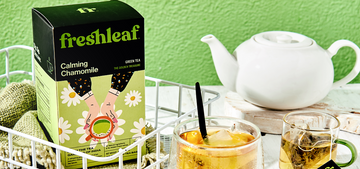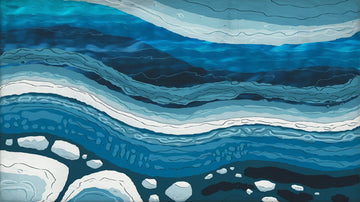Getting the water right in your tea! Best practices to brew tea
by Lovlesh Saini on Mar 22, 2025
Amid all the intrigue surrounding a cup of tea, the most overlooked ingredient is often the simplest, water. We carefully pick our tea leaves, obsess over the right accessories, and debate the perfect add-ons, yet the very foundation of tea, making up 99% of it, barely gets a second thought.
Back in the 8th century, Tang Dynasty philosopher Lu Yu wrote in the Cha Jing (or Classic of Tea) that the finest water for brewing tea came from the heart of a fast-flowing mountain stream. He also believed that the very same spring water that nourished the tea plants was the key to achieving the perfect brew.
Yu understood that pure, high-quality water needed no extra refinement. But he also knew that not everyone reading his book would have access to the best water. So, he offered a simple solution: "During the first boil, add a measure of salt appropriate to the amount of water to harmonize the flavor."
Since not everyone has access to pristine mountain water today, the next best option is to adjust and refine it for the ideal brew. Keeping a few simple guidelines in mind can make all the difference in crafting the perfect cup of tea.
NOTE THE TEMPERATURE
Every tea has its own brewing needs, and ignoring them can lead to a less-than-perfect cup. Delicate green and white teas, for example, can turn bitter if steeped in boiling water, losing their subtle flavors. Instead, they shine best at 75-80°C. Oolong teas do well at a slightly higher range of 80-85°C, while bold black teas and classic morning blends thrive at boiling temperatures. Herbal teas, on the other hand, can handle water straight from the kettle, unlocking their full flavors effortlessly.
BOIL FRESH EVERY TIME
One common mistake in tea-making is re-boiling water, but if you’re after the perfect cup, consider it a secret no-no. Repeated boiling, or even letting water sit too long, reduces its oxygen content, which can dull the flavor of your tea. Fresh water means fresher-tasting tea and oxygen brings it to life, so it’s always worth the effort to refill the kettle. Also, a handy tip: don’t overfill it unless you want to waste water!
UNDERSTANDING pH VALUE
The water you use doesn’t just affect the temperature, it also impacts the taste of your tea through its pH level. Pure water sits at a neutral pH of 7, while tap water can range from 6.5 to 9.5, depending on its mineral content. Harder water, which is more alkaline, can mute or overpower the delicate notes of tea.
For the best brew, aim for neutral water with a pH close to 7. While slightly acidic water is better than overly alkaline, balance is key when it comes to getting the perfect cup.
MINERAL CONTENT
Distilled water might have the perfect pH, but it’s far from ideal for tea. Stripped of minerals, it results in a flat, flavorless brew. Think of it like cooking without salt, the right amount enhances flavors, but too much or too little can throw everything off. The key is finding water with just the right mineral balance to bring out the best in your tea.
NOTHING LIKE SPRING WATER
For the perfect cup of tea, balanced spring water is a great choice. But if that’s not an option, a good water filter can do the trick, one that removes unwanted elements like chlorine while keeping the beneficial minerals intact. While high-quality filters may cost more upfront, they’re far more economical in the long run than constantly buying bottled water.
For the perfect cup of tea, balanced spring water is a great choice. But if that’s not an option, a good water filter can do the trick, one that removes unwanted elements like chlorine while keeping the beneficial minerals intact. While high-quality filters may cost more upfront, they’re far more economical in the long run than constantly buying bottled water.
CONCLUSION
While tea leaves get all the attention, the water you use plays just as big a role in crafting the perfect brew. From temperature control to pH balance and mineral content, small adjustments can make a world of difference in how your tea tastes. Whether you opt for fresh spring water or a well-filtered alternative, the goal is the same, enhancing the natural flavors of your tea, sip by sip.
At Freshleaf, we believe that a great cup of tea starts with great ingredients, and that includes water. So the next time you brew a cup, pay a little extra attention to what’s filling your kettle. Your tea will thank you for it!


